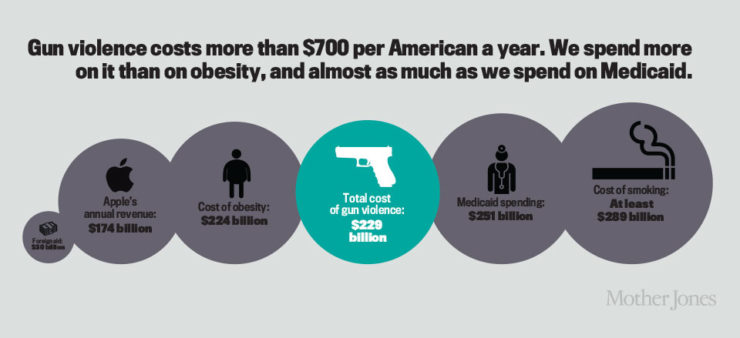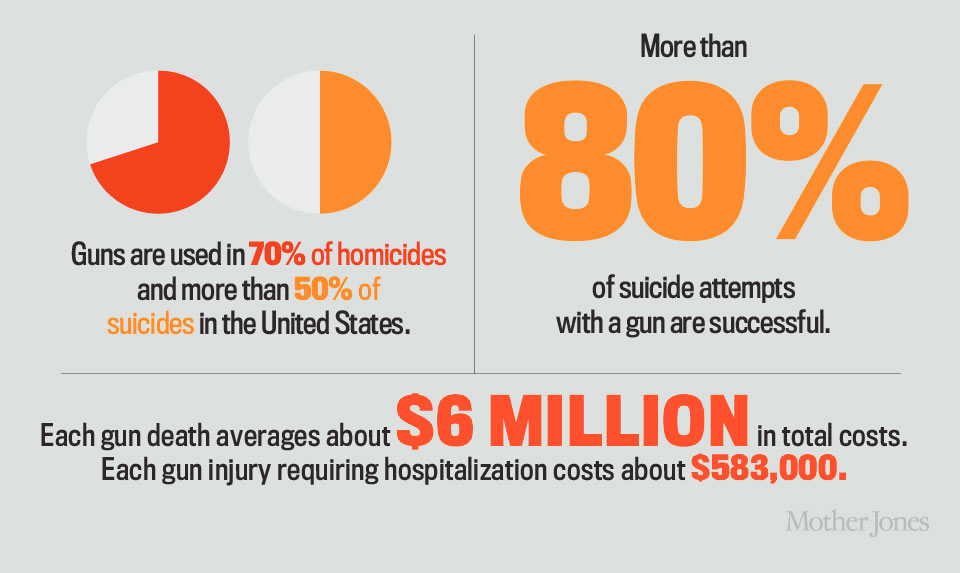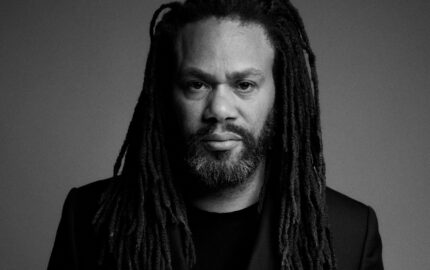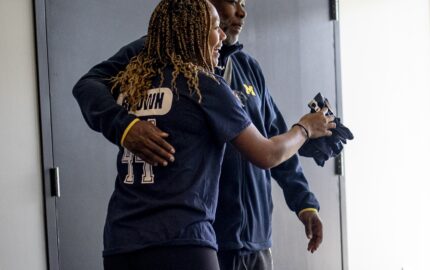Few journalists are more versed in guns and gun violence than Mark Follman. As national affairs editor for Mother Jones, Follman has led a series of landmark investigations into everything from mass shootings to child gun deaths. Even now, with President Trump occupying much of the magazine’s time and resources, Follman still finds time to report on the gun epidemic.
Perhaps his most groundbreaking project came in mid-2015, when Mother Jones published a package titled “The True Cost of Gun Violence in America.” It was the culmination of a year working with an economist to collect and analyze data, and to present, for possibly the first time, a highly scientific look at the financial costs of gun violence on society.
The numbers were eye-popping: $229 billion a year in direct costs (emergency services, police investigations, short- and long-term care) and indirect ones (lost income, impact on quality of life).
To construct a narrative around the data, Follman and his team of half a dozen reporters, research fellows and producers found innovative and affecting ways to present the data. I interviewed Follman by phone about tackling a project with no precedent, building a narrative around numbers and avoiding the pitfalls of politicization.
The interview has been slightly edited for length and flow.
"I wanted to find ways to tackle the subject that are really strongly data-driven and really show the scope of the problem without getting into the political debate."
In the story, you mention that Mother Jones was interested in the cost of gun violence since the mass shooting in Aurora in 2012. Were you involved in that initial interest, and can you talk about it?
It’s not so specific to that shooting per se, but that was just the point in time where I became much more invested in the subject of mass shootings, really focusing on it and conducting data research on it. I wrote that into the context of the piece as kind of a benchmark of time, because I had covered gun violence prior to that, but 2012 was really a major pivot point for me with that attack in Aurora. That’s the point I really started to think about: What’s going on with these mass shootings? Why isn’t there more information about this problem? And we started developing bigger projects around gun violence, too. Mass shootings have been a big focus for me and at Mother Jones, but I’ve also done projects looking at child gun deaths, and a lot of data work back then around the ways laws were changing at the state level.
What triggered this particular package, on the financial costs of gun violence in America?
It was something I had been thinking about from that time and been talking about with others on my team and with our editors as an area that really seems to almost never be discussed with respect to gun violence. I was also thinking about it in the context of mass shootings in particular, because they tend to be inordinately impactful in all sorts of ways. Psychologically, with the emotional trauma they can have, the response to them, the ripple effects they had were really intense. So part of that equation in my mind had to be the financial impact as well. And we saw that there was really no data on it, because it’s been this kind of political suppression of research over the years, it’s a difficult thing to measure, and so on. But as I pointed out in the piece, there are some difficult societal questions that have been studied in this way, so the big question became, why not this one?
We realized it was an opportunity to set out and do that. Our first step was to find out what, if any, economists were out there that had studied this. There are few, if any, who have tackled it at all.
This was a major package, with the main analytical feature, video and a separate piece with a number of gunshot survivor stories. What kind of time investment was this for you, the other reporters, the magazine?
It was a deep investment. I think, and I’m a little hazy on the details, but I think we spent about a year in total working on this, and about the last three or four months of it were pretty full time. We had a team of three reporters, including myself acting in a dual role reporting and editing, and we had a producer doing video and some research help from our fellows. It was a team of about a half-dozen people working on it full time for three or four months, and that was a culmination of about a year-long project of digging into data. It took us a long time initially just to figure out how to do the data project, involving a lot of conversations with Ted Miller, who was the economist we worked with on the data, just figuring out how to parse that in a way that made sense and would give us a good, understandable estimate of the problem but would still be a conservative estimate. We wanted to be careful not to overstate it, because there are some less tangible things we included. And I think we ended up with a conservative estimate, and the costs are likely significantly higher.
For a piece that largely highlighted the financial costs through data collection and analysis, you started and ended the story with the story of one individual, Jennifer Longdon, who had experienced gun violence and its rippling costs. Why?
We really had two components we set out to do. One was to figure out the data equation, which was quite complex, to figure out the methodology and then gather that data and analyze it. Then the other component was that I knew from the outset that I wanted to have a narrative story to wrap around it so that people would be able to relate to it. Data work is often pretty thick, and you want to combine that with good storytelling, so I was on the lookout for a good personal story that could kind of be the centerpiece. I had gotten to know Jennifer Longdon at that point through some other reporting I had done on gun violence, maybe the prior year. I had a sense of how big her financial burden was, so I started talking to her about whether she’d be willing to share more of that with me. Soon we were off and running with that, and spent time reporting her story out, too. Those were the two kind of tracks we brought together for the package.
Then as we were building it, we also thought we wanted to show this in some different ways too with some other kind of mini-portraits, so we started gathering that other group of survivors we wanted to profile as well.
Were you hesitant or concerned that Longdon’s story, since it was anecdotal and isolated, would cost you some of the objectivity and validity of your data?
I wouldn’t say that I was concerned about it. I think it was necessary to really get people to engage with the difficult computations of what these numbers mean. Because ultimately, the cost to a gun violence victim, both personally and then locally, within the immediate orbit of that person, to translate that, you really need a story you can relate to. It’s really a classic convention of good data journalism at this point. But on the other hand, I also felt like her story was really good for distilling these concepts, because you could see some very big costs to her that were direct and specific, but I think her story also was a good way to show these ideas of, what are the more intangible costs that are long-lasting that affect a person’s life and the people around them?
And that’s also why we wanted to have the other survivor mini-profiles, too, because we wanted to suggest that, you know, this is just one version of this. But I thought her story was very powerful when I started digging into the details of what she experienced, because the physical and psychological trauma she experienced was so intense, and the costs were so big that I thought it was a good way to show -- kind of in miniature -- these much bigger numbers. Really, they’re hard to relate to. We say at the top that the big grand conclusion from this is that gun violence costs the country more than $229 billion a year. How do you relate to that? You can compare it to the revenue of Apple computers, but it’s not going to give you the same sense of understanding and scale that a personal story like Jennifer Longdon’s does. So instead of taking away from it, I think it really added to the thrust of the data quite dramatically, and quite profoundly.
I agree, but I feel that as affecting and profound as that story was, I could imagine strident gun rights advocates saying something like, “Her story is an anomaly. You’re pulling that one out to distort the real evidence.” We’re living in a moment where everything that can, will be politicized.
Well, people can take a story like that and politicize it in a number of ways. But, I think it’s important to point out that one of the driving reasons why we were interested in doing this story and why were so invested is because, for me personally, I wanted to find ways to tackle the subject that are really strongly data-driven and really show the scope of the problem without getting into the political debate. There’s so much of that political debate about gun control versus gun rights, and anyone who reads about that topic is familiar with those arguments, but our goal with a project like this is to really show the problem empirically, through the data, through the stories of people who have experienced it, and let readers decide for themselves. Sure, you could say most people don’t experience what Jennifer Longdon did, but I don’t know if that’s true. I think many people understand that many people who experience gun violence have debilitating injuries, lots of people end up in wheelchairs. We had another one in the smaller survivor profiles, a young man from Richmond, Calif., who had come out of that setting of urban gang violence. I think many people would come out of her story thinking that this in fact may be more common than I realized, not a total exception.
"We really had two components we set out to do. One was to figure out the data equation, which was quite complex, to figure out the methodology and then gather that data and analyze it. Then the other component was that I knew from the outset that I wanted to have a narrative story to wrap around it so that people would be able to relate to it."
People can and will continue to have those debates ad nauseam, but that wasn’t the intention of this project at all. The intention was to show this problem in vivid detail with a particular focus on that question that I think is fundamental and in some ways very simple: What does this cost society? And it’s interesting to me that to this day, that question comes up very little in all the debates about gun policy. There’s enormous financial impact from this problem that people still don’t really talk about.
Since you had reported on gun violence prior, did you find anything over the course of reporting that really shocked you, whether about the numbers or the survivor stories or something else? Or was it just a matter of organizing and contextualizing these things for your audience?
I would say some of both. I had a sense of where this investigation was headed, but of course we didn’t know what the numbers were until we really dug into it. But I would say that the over-arching numbers we found were pretty eye-popping. That the cost was that significant on an annual basis, and the comparisons we ended up making to it, like the cost of Medicaid, or what we spend to fight obesity or Apple’s annual revenue, these are major societal problems that it’s on par with financially.
I think in particular I was surprised in regard to mass shootings, that was something that really stood out to me, too. Looking at the cost of it, which I got into a little bit with the example of the shooting at Clackamas Town Center, the mall in Portland. If you take a mass shooting and isolate it and try to apply this methodology to a mass shooting, the numbers there I thought were quite stark. And it makes sense, in the ways that mass shootings tend to have an inordinate impact in general, that it would also be true with the financial. I started measuring, looking at how many people responded to this, the shutdown of the mall for nearly a week during Christmas season and the lost revenue from that, things that a more conventional shooting wouldn’t see an impact on. But in a mass shooting you see these things that have a much more dramatic impact. There was something like 115 investigators involved in the aftermath, doing their work and developing a report. That’s a lot of paid hours of work. Things like that add up into the millions of dollars. Or in the case of the Colorado mass shooting, the cost to the justice system to carry out the trial of James Holmes, just what they had to do to seat a jury, the cost of the time and number of people involved.
You mention the “indirect costs” of gun violence, which come from lost wages and impact on victims’ quality of life. Were you interested at all in going beyond that, to the almost tertiary costs, like cooling effects on local economies in urban areas, or how entire at-risk communities can be devastated by frequent violence?
I think certainly in concept I was interested in that, and some of that is shaded into the piece. There’s some discussion there in terms of when you get these communities that are locked into this terrible cycle, gun violence can very much be a root of broader problems like that. That’s why I think one of the economists in the piece mentions that the first thing mayors of major cities talk about when they want to fix a blighted neighborhood is the gun problem. It keeps businesses away, and kids aren’t safe going to school, and so on and so forth. So you can extrapolate out even further into the socioeconomic issues that gun violence can create in a community. And then it gets even more difficult to quantify the cost. One of the techniques economists use for that is something they call quality-of-life measurements, and that is an interesting area that bears further exploration.
One thing I just remembered that stood out to me as really surprising was the shocking lack of data on the mental health costs of gun violence. There have been virtually no studies that have been done on that. The study we had to use to kind of extrapolate off of was one Ted Miller had done with a colleague back in the 1990s, I believe. And even that is a fairly small sample. There’s obviously a huge cost in terms of mental trauma and treatment people need, or aren’t getting, when they experience gun violence, and I think the numbers we ended up putting around that were very conservative. I think if you were able to get a real look at the data, it would be a much more significant cost, not just in terms of money but in terms of the quality of people’s lives, in post-traumatic stress disorder and things like that.
It’s pretty incredible that something so common, and so devastating to so many, could have so little funding for research from the government.
Oh yeah. That was a very strong theme I found among public health experts and researchers, that there was a real chill on studying this subject. Not only because there’s a lack of funds from the government, but there’s been a political chill. People know that if they get into these waters, they’re going to get attacked. I thought that was an important part of this piece, too, to convey that. We’re really leaving ourselves blind on a major societal problem because of the politics of this. People just don’t want to study it. They’d rather do other things. They don’t want to worry about the NRA coming after them. That would have real implications for people working in academia, or government. It’s not just a matter of being criticized; it’s a matter of potentially losing funding for something else if they were to kick this particular hornets’ nest.




